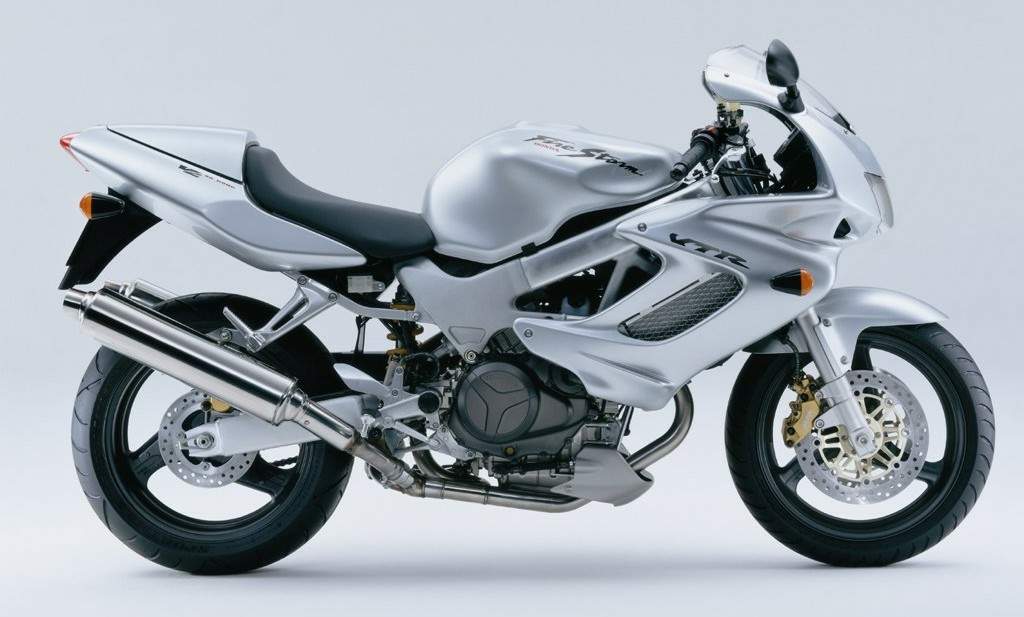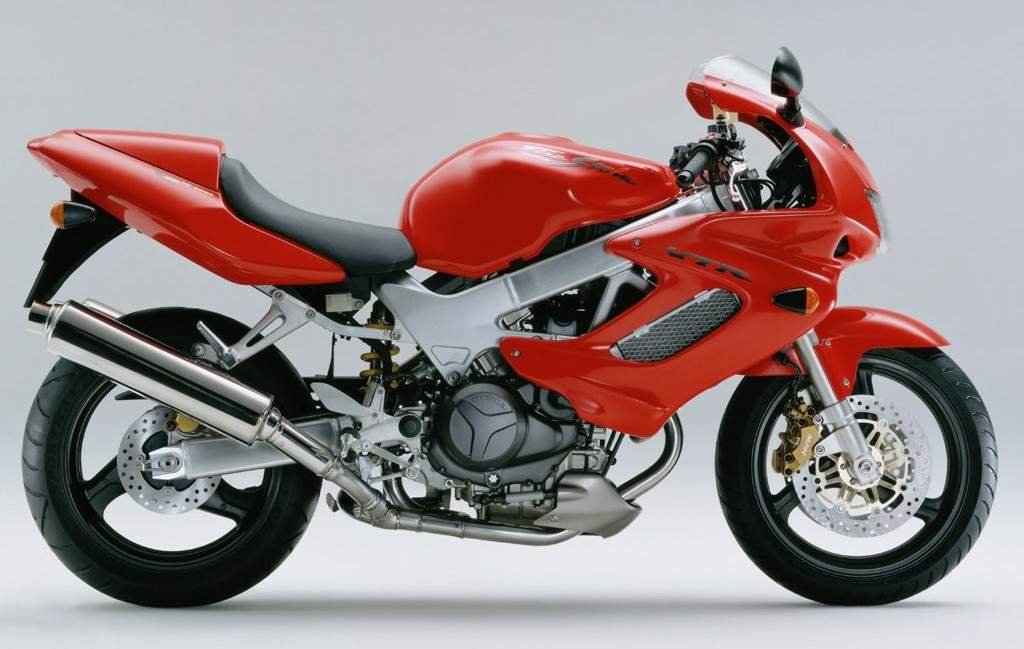
|
|
|
|
|
|
Classic Bikes
Custom Bikes
Individual
Racing Bikes AJP
AJS
Aprilia
Ariel
Avinton / Wakan
Bajaj
Benelli
Beta
Bimota
BMW
Brough Superior
BRP Cam-Am
BSA
Buell / EBR
Bultaco
Cagiva
Campagna
CCM
CF Moto
Combat Motors
Derbi
Deus
Ducati
Excelsior
GASGAS
Ghezzi Brian
Gilera
GIMA
Harley Davidson
Hero
Highland
Honda
Horex
Husaberg
Husqvarna
Hyosung
Indian
Jawa
Kawasaki
KTM
KYMCO
Laverda
Lazareth
Magni
Maico
Mash
Matchless
Mondial
Moto Guzzi
Moto Morini
MV Agusta
MZ / MuZ
NCR
Norton
NSU
Paton
Peugeot
Piaggio
Revival Cycles
Roland Sands
Royal Enfield
Sachs
Sherco
Sunbeam
Suzuki
SWM
SYM
Triumph
TVS
Ural
Velocette
Vespa
Victory
Vincent
VOR
Voxan
Vyrus
Walt Siegl
Walz
Wrenchmonkees
Wunderlich
XTR / Radical
Yamaha
Zero
Video
Technical
Complete Manufacturer List
|
Honda VTR 1000F Firestorm
|
| . |
|
Make Model |
Honda VTR 1000F Firestorm |
|
Year |
1997 |
|
Engine |
Four stroke, 90°V-twin, DOHC, 4 valve per cylinder. |
|
Capacity |
996 cc / 60.8 cu-in |
| Bore x Stroke | 98 X 66 mm |
| Cooling System | Liquid cooled |
| Compression Ratio | 9.4:1 |
|
Induction |
2x 48mm Keihin CV |
|
Ignition |
Computer-controlled digital |
| Starting | Electric |
| Spark Plug | NGK, DPR9EVX-9 |
|
Max Power |
110 hp / 80.2 kW @ 9000 rpm (rear tyre 103.1 hp @ 8700 rpm) |
|
Max Power Rear Tyre |
103.1 hp @ 8700 rpm |
|
Max Torque |
97Nm / 71.5 lb-ft @ 7000 rpm |
| Clutch | Hydraulic clutch |
|
Transmission |
6 Speed |
| Final Drive | Chain |
| Frame | Aluminium, twin spar |
|
Front Suspension |
41mm H.M.A.S. cartridge-type fork with adjustable spring preload and rebound damping |
| Front Wheel Travel | 109 mm / 4.2 in |
|
Rear Suspension |
Pro-Link with preload and rebound damping-adjustable gas-charged H.M.A.S. damper |
| Rear Wheel Travel | 124 mm / 4.9 in |
|
Front Brakes |
2x 296mm discs 6 piston calipers |
|
Rear Brakes |
Single 220mm disc 1 piston caliper |
|
Front Tyre |
120/70 ZR17 |
|
Rear Tyre |
180/55 ZR17 |
| Wheelbase | 1430 mm / 56 in |
| Seat Height | 810 mm / 32.0 in |
|
Dry Weight |
192 kg / 423 lbs |
| Wet-Weight | 209 kg / 460 lbs |
|
Fuel Capacity |
15.8 Liters / 4.2 US gal |
|
Consumption Average |
17.2 km/lit |
|
Braking 60 - 0 / 100 - 0 |
12.7 m / 37.6 m |
|
Standing ¼ Mile |
10.9 sec / 204.8 km/h |
|
Top Speed |
248.3 km/h / 154.2 mph |
|
Road Tests |
Motoplus 1997 |
| . |
After the success of Ducatl's liquid-cooled eight-valve V-twin superbikes - the 748 and 916 - many Japanese firms were expected to launch competitor bikes. The Firestorm was Honda's first entry, appearing at the start of 1997.
The specification points to a high-tech sports machine. The Firestorm is built around a 996cc liquid-cooled 90° V-twin engine, with four valves per cylinder. Large 48mm (1.9in)CV carburettors, a massive airbox and twin-silencer exhaust system help provide smooth power delivery.
This engine is mounted in an advanced aluminium trellis spar design. The swingarm pivot is actually positioned below the end of the frame, at the back of the engine cases. This design saves weight and provides acceptable stiffness for road riding, although some racers have fitted reinforcing plates between the frame and the swingarm pivot to add stiffness for track use.
The running gear is standard mid-1990s Honda sports fare. The 41mm (1.6in) front forks are adjustable for spring preload and rebound damping, as is the gas-charged rear shock, while the Nissin four-piston front brake calipers are borrowed from the firm's CBR900RR FireBlade.

While the Firestorm is well-equipped, it offers a softer sports experience than something like Ducati's 916. The suspension is designed more for the road than the
track, and while the engine is strong, it has a softer edge than some more committed sports machines.
The Firestorm isn't excessively heavy at 192kg (4221b), but still compares badly with four-cylinder sportsbikes. Honda's FireBlade has always been lighter - the 2002 model is 24kg (531b) lighter than the Firestorm. But kept in a sports touring role, the Firestorm is still satisfying, the low-down torque of the V-twin engine making for relaxed progress, and the neat half-fairing keeping the wind off at motorway speeds.

Honda VTR 1000 vs Suzuki TL 1000R
Pity the siblings of race replica motorcycles. While
the press-and the moto-public alike-froth at the mouth to throw a leg over the
newest, greatest techno-finery, many competent motorcycles get overlooked in the
melee. Imagine how a merely above-average athlete feels when compared to an
Olympian family member. How many of us could hold up under such scrutiny?
Although the Aprilia SL1000, the Honda VTR1000 and Suzuki TL1000S weren't shod
with sexy buns and tossed around the track, they don't exactly lead the lives of
wallflowers either. Call 'em broad purpose sportbikes-mounts that are as at home
in concrete canyons as granite ones or superslab-machines that wouldn't feel out
of place during the occasional track day until eight-tenths speeds were
approached. All of which made this trio the obvious choice for the SR gang of
three's trip to Sears Point for the ill-fated second round of the 2000 AMA
Superbike series.
Then again, things don't always work out the way you plan. Our plan (if you can
call it anything so organized) was to leave the emap tower around noon and spend
a glorious Friday tracing the twistiest line between two points. Unfortunately,
the realities of the work day delayed our departure until peak traffic.
Splitting lanes for more than an hour and a half through Los Angeles' worst
immediately revealed the differences among theses motorcycles in low speed mode.
Ergonomically, the VTR is the gentleman of the bunch. With its upright riding
position, ample leg room and good wind protection, the Honda felt at home on the
long and non-winding road at both low and high speeds. The Falco leaned a little
more toward a sporty upper body position, placing the bars a bit lower but
slightly rearward preventing the interstate from being a painful proposition.
The same can't be said of the Aprilia's footpeg location, which folded up longer
riders' legs rather severely and somewhat too forward for some testers' tastes.
Whil

e this isn't a problem in the twisties, SL riders
felt the need to re-adjust their lower body position early and often on the
highway. The TL-S had the raciest ergos of the bunch. The widely spaced bars
were forward and low, making crawling in traffic a wrist stressing affair. The
rearward pegs contributed to the racing crouch feel. Both the Falco and the TL-S
offered decent wind protection, but the Suzook was a bit chillier when the
temperature dropped. Riders on the upside of 5' 11" commented on the TL's
blusteriness around the helmet.
But these bikes weren't designed for chasing horizons Gold Wing style. After a
weekend of rain-drenched commuter duty, our sporting trio kicked up their heels
for the trip home. Winding our way back to Los Angeles provided ample
opportunity to put these bikes through their paces.
In the twisty stuff, the Aprilia steers the quickest, although it never felt
hyperactive. The suspension consistently managed to soak up what the pavement
threw its way, allowing spirited cornering on both smooth and bumpy tarmac.
Though detuned from Mille duty for more midrange poop, the engine suffers from a
few quirks. The Falco exhibits more than just a tendency toward
cold-bloodedness. Often, several minutes of warm-up are necessary. The fuel
injection mapping needs some refinement in the lower rpm range to fix some
hiccups, too. Grab a handful of throttle at low rpm and the Falco chatters the
chain as it struggles to overcome its tall gearing. Then there's the issue of
whether the engine is derestricted or not. Although SL owners would undoubtedly
uncork the air box and snip the appropriate wire, our test bike may not have
been EPA legal and may have had an unfair power advantage over the other two
unaltered bikes. That said, the Aprilia's engine still ranked second. The SL's
styling, however, was the trendsetter.

The Super Hawk, in typical Honda fashion, scored well in nearly every category.
Although we've said it before, the VTR's fuel range is a joke, forcing riders to
plan their trips around the all-too-frequent fuel stops. On the gas at low rpm,
the VTR also struggles to overcome tall gearing. The engine puts out good power
throughout the rpm range but the revs didn't climb quickly enough for one
tester. Vibration is a constant, annoying companion when riding the Super
Hawk-particularly in the pegs, which rigidly mount to the engine. The VTR steers
the most neutrally of the threesome, handling multiple transitions with ease.
Similarly, the TK adjustable suspension effectively negotiated the transactions
between the rubber and the road. Our testers were split on whether the VTR or
the SL handled the best. The two bikes also shared top braking honors with
strong manageable power.
The TL1000S cleaned up when it came to engine smoothness. We've always loved the
Suzuki's motor for top end power. This bike was no exception. Unfortunately, the
strongest motor was still hampered by now familiar off/on throttle fuel
injection woes, but it also surged noticeably in the 3500 to 4000 rpm range. We
suspect the surging was the result of Suzuki trying to improve the TL's fuel
economy. In mountain mode, the TL-S required the most effort at the grips to
turn in, though not enough to be bothersome. The suspension suffers from
excessive compression damping to make up for the limp spring rates. In the bumpy
stuff, the Suzook could be a handful. Although the brakes required a bit more
effort, stopping power was only slightly behind the Aprilia and the Honda.
So, when we arrived back in the L.A. basin, the SR staff put its collective
heads together to come up with a split decision. One staffer chose the TL,
saying he'd simply put some money into the suspension to bring it on par with
the Falco in handling and price. The other two selected the VTR for its
all-around competence-despite its tiny tank.
Source Sports Riker
|
Any corrections or more information on these motorcycles will be kindly appreciated. |